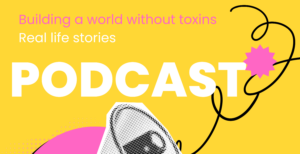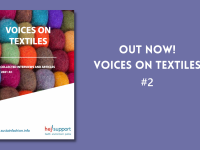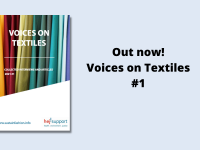Recycled Cotton is Still an Emerging Fabric

Cotton is a natural and biodegradable fiber, and its traditional cultivation and harvesting practices require the extensive use of many resources and harmful inputs, such as the intensive use of hazardous pesticides. For that matter, alternative methods of cultivation are needed for a more sustainable use of cotton in the textile and garment industry. Organic cotton is a first alternative, but it still requires heavy water-intensive practices and large amounts of land use. To address this issue, the use of recycled cotton as a sustainable alternative is emerging and creating ample opportunities and avenues for sustainable innovation for industry players.1 One significant advantage of cotton recycling is that it eliminates the requirement of bleaching, which is a highly chemical-based process.
Cotton can be recycled via two different ways: a chemical process or a mechanical process.2
- Chemical process: the chemical recycling of cotton is associated with a cellulosic process similar to that used in viscose production. The fabric is dissolved in chemicals in order to be turned into into cellulose and spun into yarn. This yarn is not cotton but actually a rayon textile. Depending on the chemical technology used in the process, this recycling is reasonably sustainable but requires further examination for safer technological practices. Most industrial chemicals are hazardous for human health and can have significant negative impacts on workers and as well as the environment and local communities, due to contamination of water sources near industry sites.3
- Mechanical process: In this process, there are two different types of cotton used: the post-industrial or pre-consumer waste and the post-consumer waste.4 The prior type is the most common cotton and includes a variety of cotton waste made during the production phase, such as yarn waste or garment cuttings. The latter type is made up of collected waste such as old garments, sheets and household items. During the process of recycling, all cotton-based fabrics and materials are sorted by color and are put through a shredding mechanism to produce smaller pieces which are then used to generate new, raw material(s). As an example shown in the figure below, the raw material can be turned into yarn and used for creating new items.5

Using the mechanical process has the advantage of needing much less primary and energy resources when compared to traditional cotton cultivation methods. However, there is also associated disadvantages; for example, the new, raw material(s) does not have the same durability and tensile strength properties as virgin cotton.6
Furthermore, recycled cotton is a very versatile material. It can be downcycled for lesser quality purposes, such as paper or furniture stuffing, and it may also be blended with other materials to enhance its desirable properties. For instance, the Texloop company blends its recycled cotton with organic cotton.7 However, the challenge with mixed fabrics causes difficulty in the next round(s) of recycling, especially when these blends contain plastic-derived fabrics such as polyester.8
Overall, recycled cotton remains an emerging sustainable fabric in the textile and garment industry. Currently, there remains challenges with regards to insufficient recycling practices, and there continues to be a growing need for further sustainable practices to support the use of recycled cotton in the industry at large.9
References
- Information extracted from Dalton, H., Fitts, M., & Hu, M-M. (n.d.). Textiles. The New Fashion Initiative. Retrieved from: https://thenewfashioninitiative.org/wp-content/uploads/2020/12/Textiles.pdf
2. Information extracted from Opperskalski, S., Siew, S., Tan, E., & Truscott, L. (2020). Preferred fiber & materials market report 2020. Textile Exchange. Retrieved from: https://textileexchange.org/wp-content/uploads/2020/06/Textile-Exchange_Preferred-Fiber-Material-Market-Report_2020.pdf
3. To find out more read our article on Viscose https://sustainfashion.info/assessing-the-sustainability-of-viscose/
4. Information extracted from Dalton, H., Fitts, M., & Hu, M-M. (n.d.). Textiles. The New Fashion Initiative.
5. Information extracted from “Recycled Cotton -Benefits and Challenges of Cotton Recycling” Textileaid Blogspot March 2019 https://textileaid.blogspot.com/2019/03/recycled-cotton-benefits-and-challenges.html
6. Information extracted from “Recycled Cotton -Benefits and Challenges of Cotton Recycling” Textileaid Blogspot
7. Information extracted from Preferred fiber & materials market report 2020. Textile Exchange.
8. See our article on recycling mixed fiber https://sustainfashion.info/closed-loop-for-textiles-is-the-way-forward-still-an-unfulfilled-dream/
9. Information extracted Preferred fiber & materials market report 2020. Textile Exchange.






